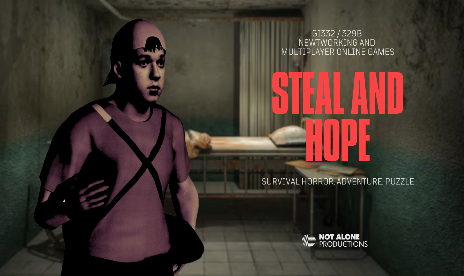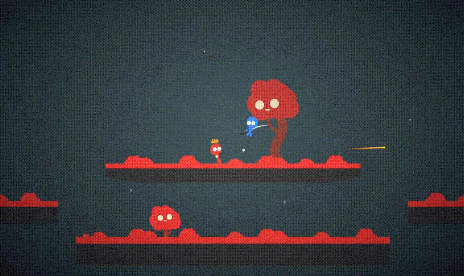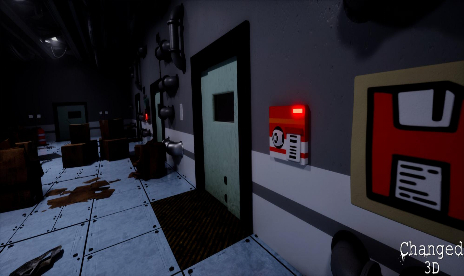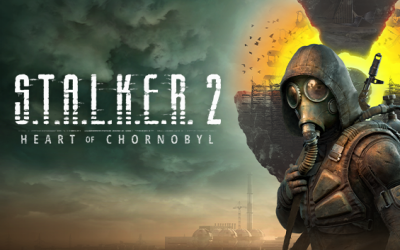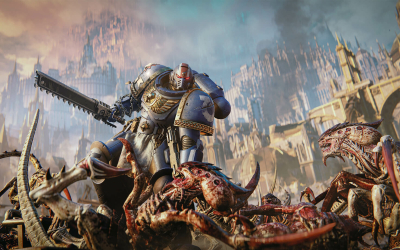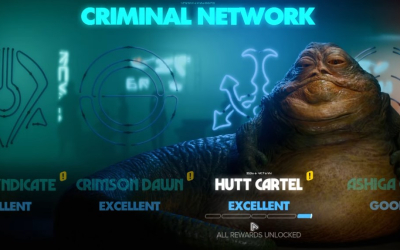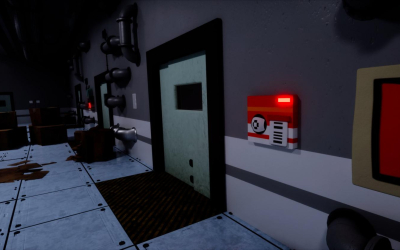Brothers in Arms
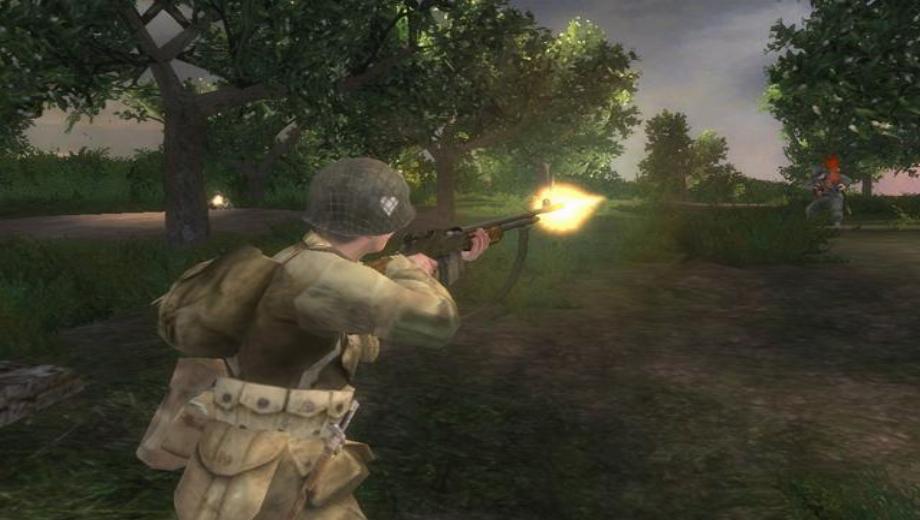
[[A Tale of Brothers]]
Texas-based Gearbox software and publisher, Ubisoft, promise to deliver a different World War II experience with their latest, first person tactical shooter, Brothers in Arms. Three and a half years in the making, Brothers in Arms will attempt to re-create the tension and drama of some of the most horrific moments of human history, while focusing on the better human qualities of friendship and loyalty.
Exactly how Gearbox hopes to achieve these ambitious goals and the combination of technology and research used, to that end, is the main focus of this preview of a title, destined to dominate game's charts for the PC and XBox, with a PS2 version also very likely, in Q4 of 2004.
The Basics
Brothers in Arms tells the story of a paratrooper who never wanted to be squad leader, but is thrust into a position leadership during the largest amphibious invasion in the history of the world. His name is Sgt. Matt Baker and he's leader of 3d Squad, 3d Platoon, Fox Company, 502 Parachute Infantry Regiment, 101st Airborne.
In BiA you become Baker and you must learn to lead your men. Baker discovers the meaning of brotherhood between soldiers and he has to deal with decisions about putting his men in harm's way in order to get the job done
[[Story Driven]]
As the genre of real-war based games has evolved, developers have realised the need to use different aspects of the conflicts in order to better place their products. The choices have ranged from changing timelines (Iron Storm), to sacrificing realism for hectic non-stop action (Call of Duty). The most recent, and probably most interesting and exciting trend, is the combination of action with realism. Games such as Medal of Honor: Rising Sun may have referenced historical battles (Pearl Harbor) but have used these events merely to provide a basic background for the game.
The recently delayed Shellshock Nam '67 however, has introduced a new concept, that of the shift from a heroic and flawless main character to a more human protagonist, one who is prone to mistakes and whose priority is to survive the conflict whatever the cost.
Gearbox has, so far, been known mainly for its uncanny ability to help publishers and developers with ports of their titles. Half-Life, Tony Hawk's Pro Skater, James Bond, Counter-Strike and Halo are just some of the games they have worked on. It was therefore necessary for the company to utilize its considerable skills and experience in order to help create a franchise title. In order to do this in the best possible way, Gearbox has gone to extreme lengths as far as resources and time, have been concerned.
Extensive Research
Gearbox co-founder Randy Pitchford provides a short list in order to give a sense of the immensity of the task and the dedication of the developers to providing an authentic experience.
Here's a list of things that members of the development team have done for research. This is a partial list and I'm a bit worried about talking about all of it because a lot of people and organizations have helped us and taught us because they believed in our sense of obligation to deal with the subject matter as authentically as we can, not because we did this research for marketability reasons:
-Sorties to Normandy, France to walk the battlefields, map them out, gather photo source, etc. Of course, our military advisor had to go during the same time of year as the invasion – on and around June 6. He spent a week there with a gentleman who is regarded by historians as the leading authority on the 101st Airborne during WW2.
-Lots of time at the National Archives in Washington DC. Anyone who's done any research there knows the magnitude of this. They have a surprising number of large metal crates full of photos and maps and reports. On one visit, Brian located the actual crusty, old After Action Reports type written by S.L.A. Marshall in 1944 that he used to document the paratrooper's pivotal role in the D-Day invasion. We've digitized the documents and are considering how to get them published (S.L.A. Marshall is a reference in just about every serious book about the invasion and I highly recommend his excellent book, Night Drop).
-Examination and cataloguing of thousands of US Army Signal Corps photos and veteran's photos.
-Study of aerial reconnaissance photographs and military maps – the same exact sources the soldiers used to memorize the battlefields and plan their strategies and tactics for each objective.
-Working with a military expert, a historian, an airborne ranger and war history author that provided us with months of master's degree level courses in military tactics and war history.
-A field training exercise managed by an active duty US Army Colonel that was designed to teach our development team combat tactics, formations, leadership and combat. We dug foxholes, marched to cadence, rehearsed battle drills, hand signals and formation calls and engaged in simulated combat of some of the battles from the game.
-Visits to the following museums: National D-Day Museum and National WW2 Museum in New Orleans (excellent museum and is worth a visit for anyone interested in the subject matter); Lots of time at the Ordnance Museum in Aberdeen with Dr. Atwater as a host – Dr. Atwater is amazing and he really cares about the importance of what he's doing – He helped us digitize weapons that civilians normally would not have access to; Visits to several of the Museums in Normandy, France – The history there is awe inspiring; A visit to the Patton Museum at Ft. Knox, Kentucky. Definitely worth a visit; There's a museum at the military base in Ft. Hood, TX where pretty much every tank I've ever heard of is parked in the fields – we climbed all over these things taking photographs and examining every square inch; The Smithsonian Institute, of course. There are great public displays in the Smithsonian American History Museum; A bunch of other places that I'm not able to go into detail on.
-Amongst us, we've read more than 500 books on the subject of paratroopers, D-Day, US Army infantry tactics, weapons, uniforms and vehicles, the German forces, their tactics and equipment and many other subjects related to war. I've personally read at least 100 books on the subject over the last three years and am now starting to feel a real command over the information and the subject matter. I bet I could teach a master's degree on the subject… Short list of recommended reading: "Currahee!" by Donald Burgett, "Citizen Soldier" and "Band of Brothers" by Stephen Ambrose, "Voice of D-Day" by Gerald Astor and "The Longest Day" by Cornelius Ryan.
-Extensive use of eyewitness accounts, personal and transcript interviews with veterans (even my Grandfather, Wid Fansler, a WW2 veteran who served in the US Army Signal Corps. He's interesting because he signed up in 1939 – most signed up or were recruited after Pearl Harbor. He retired with a rank of Lt. Col.)
-A bunch of us went to a CALFEX (Combined Arms Live Fire Exercise) and witnessed and recorded what the spectacles of warfare look and sound like. I was in NY in 1986 during the 4th of July celebration of the centennial of the Statue of Liberty (probably the most intense fireworks display of all time – including the recent millennium craziness) – that was NOTHING compared to what it's like to watch a tank blow up another tank.
We've gone out to the gun ranges a bunch of times to fire the weapons and Foley the sounds. Anyone who's ever fired an M1 Garand (or any sighted rifle for that matter) knows why the blurry iron sights up close feels correct and why the sounds in Brothers in Arms feel so natural. Also, anyone who's fired an M1 Garand and a German K-98 back to back knows the advantages the standard US rifle team had over the standard German rifle team. Of course, then we have to think about the German MG-42 – the German infantry squad tactics were centered around the machine gun…
Are you still reading this list? Think about this if you've read this far – Each item on this list represents 100's of man-hours of effort towards the authenticity of Brothers in Arms… The crazy thing is that I can say with sincerity that game or no game, the experience I've had with this material was very much worth my time and is worth the study by anyone who chooses to dive into the material.
[[GamePlay]]
Authenticity, an immersive atmosphere, extensive research and a great storyline are definitely important aspects of a game but without the appropriate gameplay you might as well write a book. Thankfully, Gearbox knows all about combining a variety of elements in order to produce an immersive game, rather than just a big budget title.
The company describes the game as providing fresh tactical team based game-play and something different than what gamers have experienced before.
Consistent with its title, BiA will ask gamers to go beyond the limits of an FPS title and to consider tactics as well. Part of the theme of the game is that it's about Baker and his squad. You're a reluctant squad leader, based on a real guy called Harrison Summers. He was a member of what's called the 30 A Day Club, which means he got over 30 kills each day in action.
This guy is a Sergeant, he's got a squad underneath him, so the game is to not only to lead these men but to gather them. When the paratroopers dropped into Normandy all over the place a lot of them found themselves alone and they had to regroup and accomplish whatever objectives they could.
So this means two things for the game – it's fun to build up the squad over time but it also allows players to ramp the skills of learning how to command a squad, which is a little bit different from tactical games in the past which expect you to know everything right from the first mission.
Squad based combat in Brothers in Arms is amazingly easy to command, but very robust. At the point in the game where you've finally gathered your scattered squad, you'll be equipped with two teams. One team is an assault team and is designed for closing-in on and killing the enemy. The other team is a fire team and is trained to suppress and pin the enemy so that the assault team can do its work. These two teams are dependant upon each other and their power is under your control.
Controlling them is simple. One button toggles between the teams. This is a lot like switching weapons, but you're switching teams. Another button issues a command. It's just one button to issue a command. You look at something and you press the command button and it's all taken care of with the context sensitive system. If you're looking at the ground, the command is, Move to that position! If you're looking at an enemy, the command is Attack! You can hold the button down to see a little indicator that tells you exactly where you'll be issuing your command.
Squad combat should be about the idea of how you want to approach the combat problem. Not about how you're going to fight through the interface to find the right command.
The game will also give players an extra advantage by offering the Situational Awareness View. This option will give the player inside knowledge of the area the soldiers already knew. During WW II soldiers studied aerial recon photos, had sand tables of the battlefield and therefore knew the terrain. As the player you don't, so the Situational Awareness View will offer a 3D view of the terrain with your units and sighted enemies clearly marked, useful for tactical decision making.
The dual nature of the gameplay will allow players to resolve encounters without firing a single shot or to jump in and take out the Germans themselves. So the game can be played as a traditional first-person shooter or become a really tactical experience. Having good tactical awareness skills will be important since there are some tough missions. As the game progresses you will have to deal with increasingly more difficult and more powerful enemies.
While playing you will always have to be aware of how your team is doing and of your casualties. Although trying to protect your team, you are bound to experience heavy losses. Gearbox has mechanisms in place so that mistakes made early-on will not cost you in later missions.
[[Technology]]
Gearbox has definitely gone out of its way to stress the levels of realism and authenticity involved in the game. According to the company this did not mean that it had to sacrifice technology but rather that exciting new features are used as an enhancement to the realism. One such example is the use of physics.
Physics
Achieving a realistic battlefield cannot be done if the effects of the weapons of war are not correctly depicted. Gearbox has hinted that a third-party physics engine will be used in order to re-create the effects of the devastating weapons used in WW II.
The developers also claim that their version of the physics engine will be one of the first to include animals as well as humans and objects. So expect a variety of farm animal parts flying about you as you fight the Germans.
AI
Gearbox has written an entirely new AI system which they have called Situational AI. It allows designers to give the Germans commands in the same way players give the Allied troops under their control commands. So what the designers can do is understand what the player is doing and give the Germans the appropriate commands to reposition themselves.
The soldiers behave like trained soldiers. They have standard operating procedures and battle drills that are designed to help soldiers respond to any situation. This is all engineered into the characters. As their commander, the player will not need to tell them exactly what to do, where to look and what they should do when someone starts shooting at them. They will know what to do. Players, as their leader will have to use the squad to fire and move-in on the enemy. Your team will know how to climb over walls and fire over obstacles, they know how to use the terrain for combat advantage.
Multiplayer
The Xbox and PC versions of Brothers in Arms will feature multiplayer action. Plans call for each online player being in command of a squad. So the player will be asked to use his fire team to out-manoeuvre the enemy online like in single-player missions.
There will be 12 multiplayer missions, each mission being similar to a single-player mission in the sense that each side will have an objective to accomplish. Each of these 12 missions will almost be a different game mode because of the unique objectives in the missions.
In one example of a MP mission, the Allies will have to take out an AA gun and the German team will be trying to shoot down bombers, therefore using the AA gun. Each side has competing objectives that cross over. According to Randy Pitchford, The other thing about multiplayer is it turns over very quickly, kind of like Counter-Strike.
It's especially important that this is a tactical game. I'll make decisions about tactical manoeuvres at the beginning that'll affect how well I do. It's a bit like in RTS games where you make decisions about your build order and it screws you an hour later if you've made bad decisions. But we didn't want that to screw you an hour later so we've made multiplayer rounds really fast – no round is longer than 10 minutes.
Multiplayer on Xbox Live will support 16 characters, a combination of AI and human characters. Randy Pitchford again, We have a lot of options for setting multiplayer games up, like I can play me versus you and we could be on Live or we could be on LAN or we could be playing on split-screen and I could have me and you versus other people… You can set it up however you want to, any combination of split-screen and LAN together. Maximum number of players on split-screen is four.
On PC we haven't yet done our bandwidth test but we're thinking we're going to be able to support a lot more players.
Gearbox also promise a variety of extra content, including three new single-player missions, which for the XBox, will be made available through XBox Live, while for the PC will become available as free downloads.
[[Final Thought]]
Brothers in Arms seems to have a lot going for it. An experienced developer, unlimited resources and a true passion from the creators to offer something new in the genre. There are however, some points which Gearbox will have to concentrate on in order to avoid disappointment.
The most important one is that the recent onslaught of WW II titles, leaves the company with the task of convincing gamers that this is something different. Many gaming enthusiasts may, justifiably, believe that they have seen all there is to see in WW II games and Gearbox will have to produce a title that truly escapes from those we have already seen tackling that conflict.
Another point the developers should watch out for, is getting the combination of the elements of gameplay right. Many games have tried to combine two gameplay styles and most have fallen victim to the gaming equivalent of no-mans-land. If the chemistry of the gameplay elements is not exactly right, players could find themselves struggling with a title that is neither an FPS nor a tactical shooter.
The visual aspects of the game are a part where the Gearbox experience has shone through and BiA looks stunning. Combined with the knowledge that the countryside you are seeing is identical to real-world locations, an exciting, immersive effect is created.
The sounds, weapons and every other aspect of the game, are authentic and that is bound to create a large following.
October 2004, is not that far away and time will soon tell how Brothers in Arms will fair in the increasingly competitive games market. Whatever its future however, it is a title we will be eagerly awaiting to try out.





![S.T.A.L.K.E.R. 2: Heart of Chornobyl v1.7.1 (+25 Trainer) [Baracuda]](https://9588947a.delivery.rocketcdn.me/wp-content/uploads/2024/01/stalker-2-heart-of-chornobyl-1-464x276.png)

![Borderlands 4 v1.0-v1.2.0+ (+45 Trainer) [FLiNG]](https://9588947a.delivery.rocketcdn.me/wp-content/uploads/2025/09/Borderlands-4-01-464x276.jpg)



